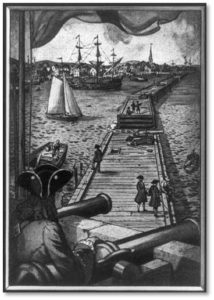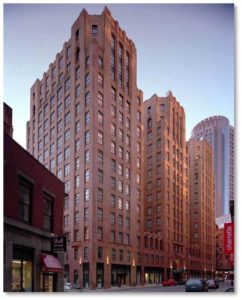Streets may be named for notable people or important places. Today, many developers name residential streets for their wives and children. But a street may also get its name for a function that it performed.
This was the case for Boston’s Batterymarch Street. In the 21st century the word Batterymarch conjures up images of EverReady D-Cell batteries on parade but it originally had a more martial meaning.
Located in the Financial District, this crescent-shaped street today runs from Hawes Street to High Street. In the seventeenth century it led to the city’s South Battery.
Fort Hill and the Town Cove
Also known as The Sconce, the South Battery consisted of a small detached fort on the eastern foot of the appropriately named Fort Hill. This military installation was located at the south tip of a body of water called the Town Cove.
- Where is Fort Hill now? It was cut down in 1868 and 1869 and its clay underlies Atlantic Avenue.
- What happened to the Town Cove? It was filled in during the land-making process and the south tip became the site of Rowe’s Wharf in the 18th century. It is now the Boston Harbor Hotel.
The South Battery
The General Court of Massachusetts ordered the South Battery built in 1666 not to protect Boston against the British—the citizens of Boston at that time were British. City fathers constructed the fort because the third Anglo- Dutch War (1672–74) was imminent.
The Battery had a company of soldiers assigned to it—but only one gunner in peacetime. In the 1740s, however, the Battery was extended into the harbor and defended by 35 guns. Merchant and developer John Rowe bought the land in 1764 and built Rowe’s Wharf, extending it into Boston Harbor.
Batterymarch Street
The street gained its name from the company of British soldiers that marched from their barracks to the South Battery and back again every day. What could be simpler?
Around 1800, a consortium of investors that included the entrepreneur Uriah Cotting, Francis Cabot Lowell and sea captain Henry Jackson commissioned Charles Bulfinch to create plans for 10 retail stores. They offered these stores for sale at $5,000 apiece, a sum that could be paid in installments over years.
Mr. Bulfinch was an extraordinary architect but a terrible businessman.The investors probably paid him as little for the Batterymarch Street shops as they later did for his Broad Street plans—about $40. That’s a paltry $573 in today’s money.
For years the street housed taverns and coffee houses.
The Batterymarch Building
In 1928, the Batterymarch Building,a 165-foot art-deco tower went up. Designed by Harold Field Kellogg, it was first called the Public Service Building and is now the Hilton Boston Downtown/Faneuil Hall, which Is on the list of Historic Hotels of America.
You can see the Batterymarch Building on Boston By Foot’s tour of Art Deco in Boston’s Financial District.
The British Regulars who garrisoned the South Battery would be awed marching past such an enormous and ornate building, around a hill that no longer exists, to a fort that’s now a luxury hotel with a four-star restaurant.
Time, like the soldiers, marches on..




